Madeira
The archipelago has an individuality that distinguishes it from the rest of Portugal. Its beauty is varied, from the flowery elegance of Funchal to the remote inland craters.
Main Attractions
The discovery of the Madeiran archipelago, 608km (378 miles) west of Morocco, was an early triumph for the ambitious seafarers inspired by Prince Henry the Navigator. In 1418, while sailing south to explore the West African coast, the caravels of João Gonçalves Zarco and Tristão Vaz Teixeira found shelter on a low-lying island they called, in gratitude, Porto Santo (Holy Port). Two years later they returned, to discover a large mountainous island 37km (23 miles) to the southwest, which they named Ilha da Madeira – the Island of Wood. Madeira Island and Porto Santo remain the only two inhabited islands in the archipelago.
Modern explorers will find that Madeira is still a wild and idyllic place to visit. Its great forests have gone – burnt down by the first settlers with fires that got out of control and are said to have raged for years – but man has contributed his own wonders to an Atlantic island whose natural splendour has earned it such titles as “God’s Botanical Gardens” and “The Floating Flowerpot”.
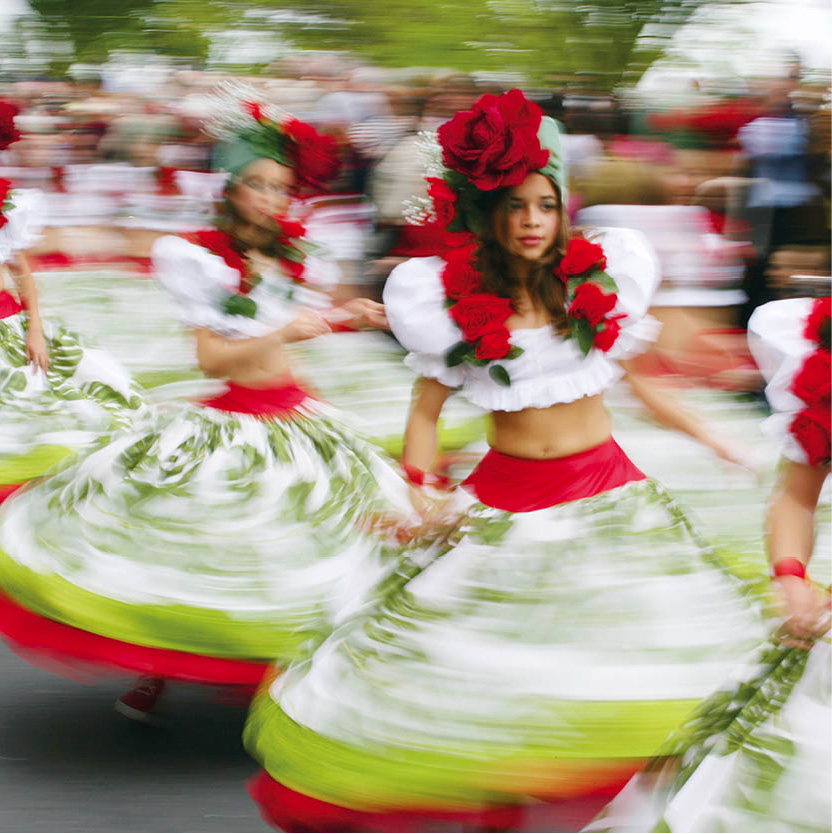
Dancers at the Funchal Spring Flower Festival.
Pictures Colour Library

View of Camara de Lobos.
Pictures Colour Library
The city of Funchal
A statue of Gonçalves Zarco now stands as a central landmark in Funchal 1 [map], the capital of Madeira and home to a third of the 270,000 islanders. The city squats in the centre of a wide bay on the sunnier south side of the island, its name inspired by the wild fennel (funcho) that the discoverers found growing on the surrounding plain. Behind it rises a natural amphitheatre of terraced hills and mountains that provide shelter from the northeasterly winds that frequently blow over the island – rain, storms and consolatory rainbows are the price you pay for Madeira’s splendid verdant landscape.
Cruise-ship passengers and tourists with limited time usually settle for the two essential Madeiran experiences, the Monte toboggan ride and tea at Reid’s Palace Hotel. The first of these involves taking the cable car or driving up to Monte 2 [map], a cool and leafy hilltop resort with quintas, sanatoriums and the Monte Palace Tropical Gardens. The nearby twin-towered church of Nossa Senhora de Monte contains the tomb of Emperor Charles I of Austria. From here you can descend to Funchal by carro de cesto, a kind of wicker sofa attached to wooden runners that is guided 2km (1.2 miles) down the steep lanes by a pair of drivers wearing boaters and white flannels. This unique form of transport was invented by an English resident looking for a speedy way to get down to his office from his quinta.
Tea at Reid’s Palace Hotel is far less strenuous, and simply involves climbing into a wicker armchair, and ordering a pot of Earl Grey tea and some crustless cucumber sandwiches. A world-famous five-star hotel with a prestigious site overlooking Funchal harbour, Reid’s was opened in 1891 to cater for the growing number of well-to-do visitors to the island – particularly the British, who liked to stop over en route to and from their colonies.
The British presence on the island has proved influential in many ways – besides endorsing Madeira’s reputation as a refined holiday destination acclaimed for its civility and hospitality, their fondness for cane furniture, acquired in the Orient, stimulated the island’s wicker industry centred on the eastern town of Camacha (for more information, click here). Another important cottage industry, the production of an intricate and understandably expensive kind of embroidery (bordados), is indebted to an Englishwoman, Elizabeth Phelps, who introduced it to supplement local incomes after disease devastated the island’s vines, with disastrous effects on the islanders’ living standards, in the 1850s. Rua dos Murcas is the best place to buy.
More recently, there has been another presence on the island that has hit the headlines: Cristiano Ronaldo. Recognised as one of the world’s top footballers, Ronaldo is now Madeira’s most famous native son, and just about everywhere you go in the capital you will see his face staring out from mugs, T-shirts and dishcloths. It’s an image that also reminds visitors that Madeira has moved on from its bygone image of starched British gentility.
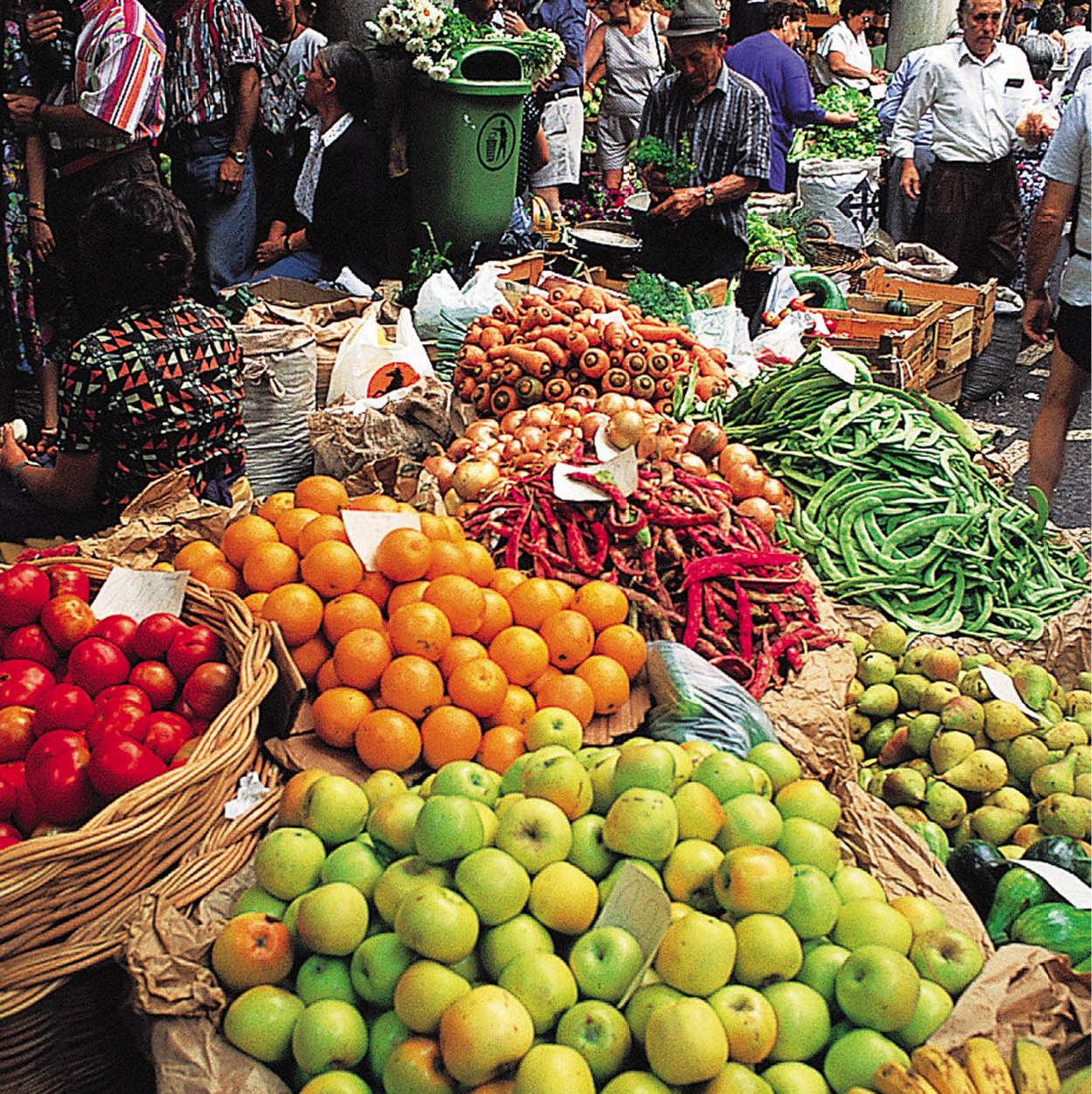
Funchal’s Mercado dos Lavradores.
Phil Wood/Apa Publications
Lomquats and scabbard fish
Funchal’s true pleasures are woven into the everyday life of the city. A visit to the Mercado dos Lavradores (Workers’ Market), a cornucopia of good things, costs nothing – unless, of course, you are tempted to buy some lomquats, tomarillos, pittangas or any of the many other exotic fruits and vegetables grown on the island.
Venture into the mercado’s inner halls and you can gaze in safety upon the gloriously ugly espada (scabbard fish) that frequently features on Madeiran menus (not to be confused with the equally common traditional dish called espetada – beef cooked on a skewer over a wood fire scented with laurel twigs). Despite its vicious teeth and eel-like appearance, espada tastes good and is something of a rarity as it is only caught here and off the coast of Japan. The most important catch in the archipelago, the fish lives at a depth of up to 760 metres (2,500ft) and is hunted year-round by fishermen from Câmara de Lobos 3 [map], just west of Funchal. They use lines with baited hooks and flies spaced at regular intervals that can be more than 1.6km (1 mile) in length.
For a rewarding insight into Madeira’s past, there are several places worth visiting: the oldest wine lodge, Old Blandy’s Wine Lodge (www.theoldblandywinelodge.com; Mon–Fri 10am–6.30pm, Sat 10am–1pm; charge for tours) on Avenida Arriaga, dates in part from the 16th century, and you can wander around at will or join a tour where the process behind the famed Madeiran wine production is explained. Tasting is also available.
For a photographic glimpse into the past, check out the Museu de Fotografia Vicentes (www.photographiamuseuvicentes.com.pt; Mon–Fri 10am–12.30pm, 2–5pm) in Rua da Carreira, which houses a collection of old photographs of life on the island as recorded since 1865 by the Vicente family. Continue your history lesson at the Museu Quinta das Cruzes (Calada do Pico 1; Tue–Sun 10am–12.30pm, 2–5.30pm), the former residence of João Gonçalves Zarco, who discovered Madeira and became its first governor. The quinta is now packed with art treasures and the attractive gardens stay open throughout the lunch break. They are one of several exotic oases around the city, which include the Boa Vista Orchids and, the largest, Jardim Botânico (Botanical Gardens), on Caminho do Meio.
Housed in a beautiful 17th-century palace at Rua Mouraria 31, the Museu Municipal do Funchal (História Natural) (Tue–Fri 10am–6pm, Sat–Sun noon–6pm) documents the fauna and flora of the island.
Most of Madeira’s hotels are located on the west side of the capital – only a short bus or taxi ride from Funchal’s main square, Praça do Município. Decorously paved with black and white stones, this is bordered by imposing buildings with whitewashed facades and dark basalt outlines that remind visitors how Church and State have lorded it over this Portuguese outpost. A Jesuit church and college, founded in 1569, fills its north side, while the 18th-century Câmara Municipal (Town Hall) to the east was once the palace of the Conde de Carvalhal. The count’s country residence was at Quinta do Palheiro Ferreiro, 8km (5 miles) east of Funchal, which is now a 320-hectare (800-acre) estate owned by the Blandy family, with magnificent gardens open to the public (www.palheirogardens.com; daily 9am–4.30pm).
On the south side of Praça do Município, the former Bishop’s Palace houses Madeira’s principal art museum, the Museu de Arte Sacra (Museum of Sacred Art; www.museuartesacrafunchal.org; Tue–Sat 10am–12.30pm, 2.30–6pm, Sun 10am–1pm). Among its exhibits is a fine collection of 15th- and 16th-century Flemish paintings acquired during the island’s profitable trade in sugar with Flanders. “White gold” was the spur that provoked Madeira’s rapid colonisation – by the 1450s merchants from Lisbon had established lucrative plantations on the island, worked by slaves brought over from Africa and the nearby Canary Islands, 416km (258 miles) to the south. By the 17th century, most of Madeira’s terraces had been given over to producing its eponymous fortified wine, originally derived from Cretan vines introduced to the island by Henry the Navigator. Among these was the sweet malvoisie grape, which gave rise to the malvasia or malmsey wines that so besotted Europe in the 16th century. In Shakespeare’s Henry IV, Falstaff is accused of selling his soul for “a cup of Madeira and a cold capon’s leg”.
For exquisite tiles, check out the delightful little Casa-Museu Frederico de Freitas (Tue–Sat 10am–5.30pm) on Calçada de Santa Clara, which has an exhibition of tiles from around the world, including Turkey, Syria and Holland, as well as other beautiful decorative arts dating from the 16th century.
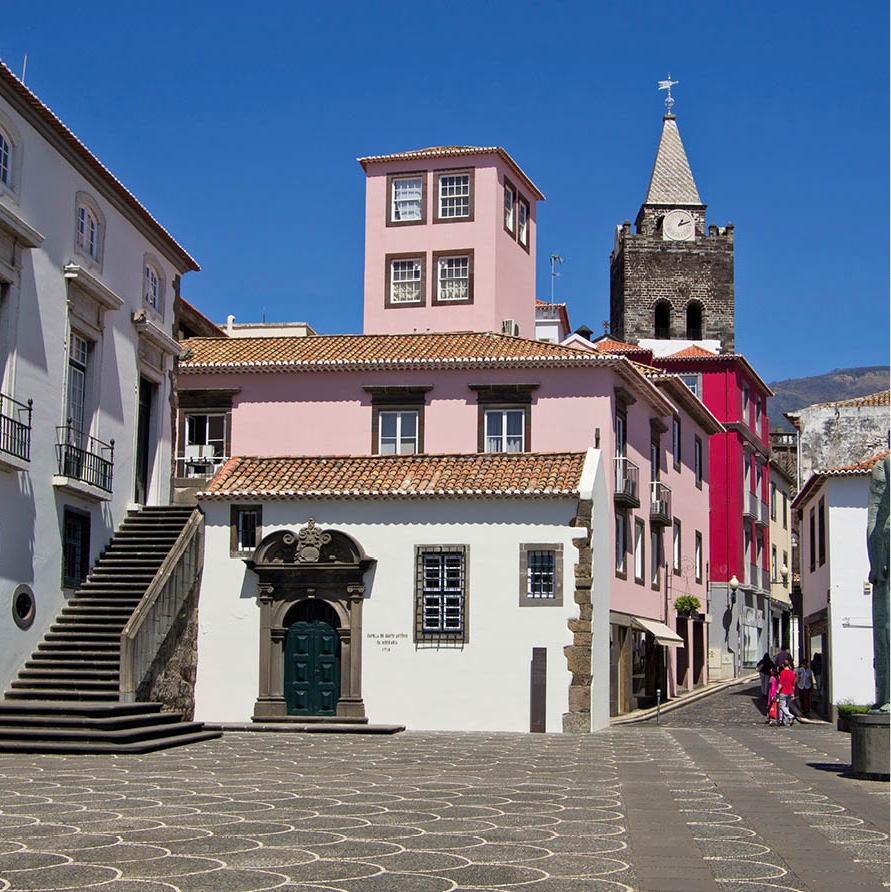
Pretty square, Funchal.
iStockphoto.com
Tip
Madeira’s network of buses provides an excellent way of travelling around the island, if you don’t feel like driving. Buses serve virtually every corner of the island, originating from Funchal’s various privately run bus terminals. Tickets can be bought on board and timetables are available at Funchal’s main tourist office.
Wine routes
Madeira wine travels and keeps well and few visitors leave without a bottle or two. Funchal has many invitingly fusty wine lodges and tasting bars where you can indulge in some serious research. D’Oliveiras on Rua dos Ferreiros, is worth seeking out, while Barbeito Wine Lodge on Estrada da Ribeira Garcia is a smaller traditional producer with a small tasting room and shop. The most comprehensive initiation into the history and production of Madeira wine is provided by Old Blandy’s Wine Lodge (for more information, click here).
Fact
The maintenance paths running alongside the irrigation channels, or levadas, that water the terraces provide 3,200km (2,000 miles) of long, level walks – a pleasant surprise on this mountainous island – into the silent heart of Madeira, with the stream of water serving as a faithful companion.
Take any road out of Funchal, and the arduous work required to produce the island’s wines, fruit and other crops soon becomes apparent. The true heroes of Madeiran history are its farm labourers and their enslaved predecessors, who over the centuries toiled to win cultivable land from the island’s steep and irregular terrain. Workers resolutely sculpted the island with staircases of tiny stone-walled fields – sometimes built by suspending men on ropes from above, with baskets of soil carried up from the river beds far below. These poios, or terraces, are fed by a phenomenal network of irrigation channels, known as levadas, that today run for thousands of kilometres (see margin), including 40km (25 miles) through tunnels.
The Island’s Wine
Madeira’s fortunes have long been entwined with those of its famous sherry-like drink, and the names of English, Scottish and Irish immigrant families such as Leacock, Cossart, Gordon and Blandy have become synonymous with the island’s history. In the 18th century it was discovered that long sea voyages through the heat of the tropics, far from spoiling the wine, improved its quality. This lengthy process of maturation has now been replaced by the estufagem system, whereby young wine is stored in hothouses (estufas) for several months. Four main types of Madeira are produced today: a dry Sercial and medium-dry Verdelho, both ideal as aperitifs, and the richer Bual and dark, sweet Malmsey, which are both often served with desserts.
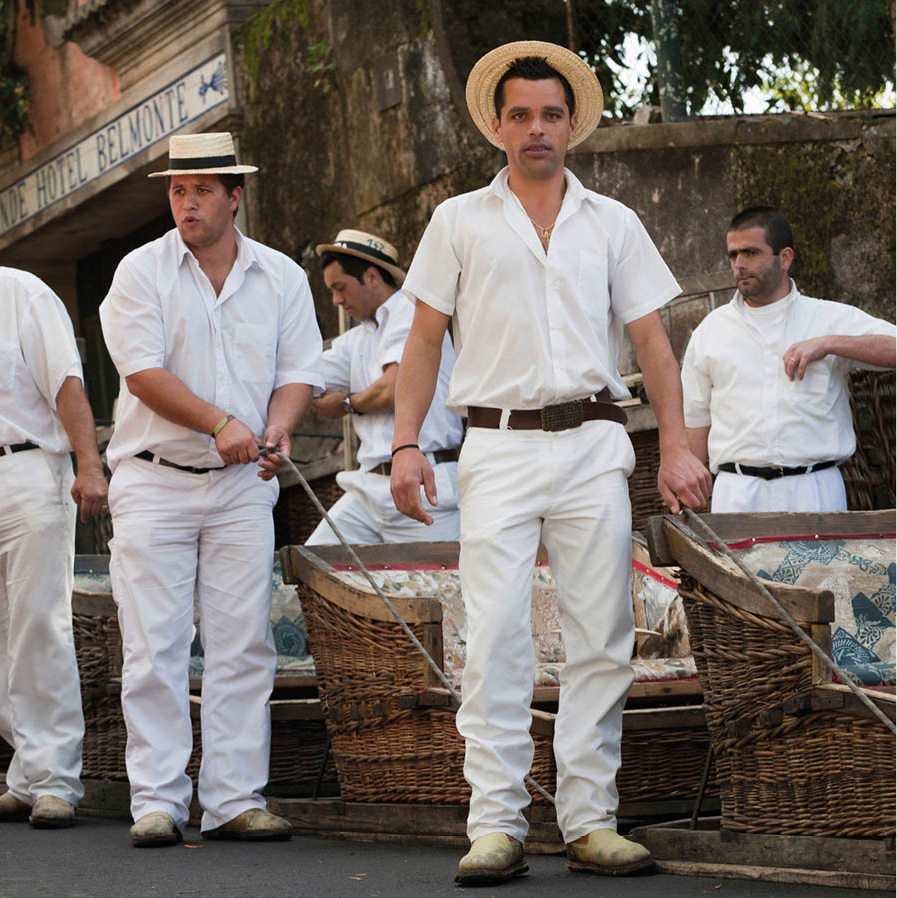
Toboggan men waiting at the top of the run.
iStockphoto.com
Peaks, cliffs and villages
Even without the terracing that has transformed the island’s landscape into a precipitous work of art, Madeira would be staggeringly attractive. A range of volcanic mountains runs east–west across the island, rising to a central conference of peaks, of which the highest is Pico Ruivo 4 [map] at 1,862 metres (6,109ft). The nearby summit of Pico do Arieiro 5 [map], which can be comfortably reached by car, provides a physical and spiritual high point. From here, providing you have prayed away the clouds, you can follow an exhilarating on-top-of-the-world path across the peaks to Achada do Teixeira.

Picturesque São Vicente.
Superstock
From all sides of these central mountains, deep ravines run seawards to boulder-strewn beaches where small villages have grown up – most spectacularly at Ribeira Brava 6 [map] and São Vicente 7 [map], directly opposite each other on the south and north coasts respectively. The ridges above them invariably culminate in sheer cliffs that are among the highest in the world. If you have the head for it, a viewing platform at Cabo Girão enables visitors to contemplate a vertical drop of 580 metres (1,900ft).
Along Madeira’s wild north coast, narrow roads have been stitched into the cliffsides, threading through tunnels, round hairpin bends and under waterfalls that provide a free and unexpected car wash. Porto Moniz 8 [map], a weatherbeaten town on the island’s northwestern tip, with several small hotels, fish restaurants and volcanic rock pools, provides a welcome goal for adventurous motorists searching for the raw side of Madeira.

A classic A-shaped cottage in Santana.
Phil Wood/Apa Publications
Other popular ports of call are the village of Santana 9 [map], on the northern coast, where the islanders’ traditional A-shaped thatched cottages have been colourfully restored, with a couple open for visitors; the forest resort of Ribeiro Frio ) [map] on a winding road that traverses the island between Funchal and Santana; and, closer to the capital, the wicker-making centre, Camacha ! [map], towards the east of the island.
For all this natural drama, Madeira is a fundamentally benign and relaxing island. Blessed with fertile soil, abundant water and an equable subtropical climate, the countryside is graced with a profusion of native plants and flowers that have been supplemented by exotic imports. Orchid enthusiasts can check out the Jardim Orquídea (Pregetter’s Orchid Garden; www.madeira-orchid.com; daily 9am–6pm) on Rua Pita da Silva in the capital, which has thousands of varieties on view. The island is a heaven for walkers and the botanically inclined, with the mountain pass at Boca da Encumeada and the Parque das Queimadas popular starting points for hikers.
Two-thirds of the island is a protected area, and the Laurisilva forest, which occupies one-fifth of the land between 330 metres (1,000ft) and 1,300 metres (4,250ft), is a Unesco World Heritage Site.
Off the beaten track
Like all good islands, Madeira has plenty of secrets. An easy and worthwhile trip from Funchal is up to Curral das Freiras @ [map] (Corral of the Nuns), a secluded crater-like valley that until the late 1950s could only be reached by the narrow mountain paths that still snake down its sides. It gets its name from the nuns of Funchal’s Santa Clara Convent, who fled here in 1566 when French pirates sacked the capital. Another pleasant surprise lies to the west of Ribeira Brava – a plateau of austere and often misty moorland known as the Paúl da Serra, where a tiny white statue, Nossa Senhora da Serra, supervises the grazing sheep and cows.
The east side of Madeira is less mountainous and is consequently the most developed part of the island. Here you can find the airport, two golf courses, stretches of intensive farmland and Machico £ [map], which can claim to be Madeira’s second city even though it only has 13,000 inhabitants, one high-rise hotel and a seafront commandeered by a sandy football pitch.
In the northeastern corner of the island the mood changes again as the land narrows to a low-lying, sandy peninsula called Ponta de São Lourenço, reached through a tunnel to the north of Machico. Here Caniçal was, until 1981, the island’s principal whaling station.
Continue to the end of the headland, which offers good views and blustery walks, and you will often meet old men selling souvenirs carved from redundant stocks of whalebone.

Splashes of vivid bougainvillea.
Gil Gavin/Apa Publications
Porto Santo and other islands
The arid landscape of Ponta de São Lourenço provides a foretaste of that found on Madeira’s neighbouring island, Porto Santo $ [map]. The sleepy world of Porto Santo is a relatively accessible one, connected daily by ferry (two hours) and aeroplane. The island is a complete contrast to Madeira: while the former has a surplus of mountains, water and vegetation but no beaches to speak of, Porto Santo has just a few parched volcanic hills and a south coast that is one long, 7km (4-mile) stretch of unspoilt sand. It is as if God were planning to add beaches to Madeira but, like a builder who leaves a pile of sand outside your front door then disappears, he somehow forgot.
This divine oversight is a blessing both for beach-lovers and for connoisseurs of small-island life, as well as wind- and kite-surfers who hold competitions here. Plagued by rabbits and erosion, and vulnerable to attack by pirates, Porto Santo has always been ignored in favour of its lush and fertile neighbour, but it is nevertheless well worth a visit.
The capital, Vila Baleira % [map], makes a virtue out of such inertia, and has only recently made efforts to cash in on its most famous resident, Christopher Columbus. The explorer was among the many sugar buyers who came to the islands in the 1470s, and later married the daughter of Porto Santo’s first governor, Bartolomeu Perestrello. It is a leafy and attractive town with a palm-shaded main square and a tempting beach.
During the summer, holiday-makers from Funchal and mainland Portugal flock to Porto Santo, giving it the semblance of a seaside resort. But even at the height of the season there is space enough to wander along its magnificent beach. And, if that is your thing, to enjoy the island’s 27-hole golf course.
Porto Santo is linked underwater to another separate group of islands, the barren Ilhas Desertas. Only 16km (10 miles) southeast of Madeira, they rise as high as 480 metres (1,570ft) and can easily be seen from the main island’s southern shores. Despite repeated attempts over the centuries, settlement of the two islands – Deserta Grande ^ [map] and Bugio & [map] – has proved impossible. They are now a nature reserve where sea birds, wild goats, venomous black spiders and a colony of monk seals live in curious harmony. The Ilhas Desertas can sometimes be visited by boat trips from Funchal, and if you are interested in wildlife and wilderness regions it is worth enquiring at the tourist office.
Another set of islands also belongs to the Madeiran archipelago and is even more inhospitable than the Ilhas Desertas. Known as the Ilhas Selvagens, these lie 215km (135 miles) south of Madeira. Despite being closer to the Spanish Canaries, they remain under Portuguese jurisdiction.

Farmer tending sweet potatoes.
Pictures Colour Library
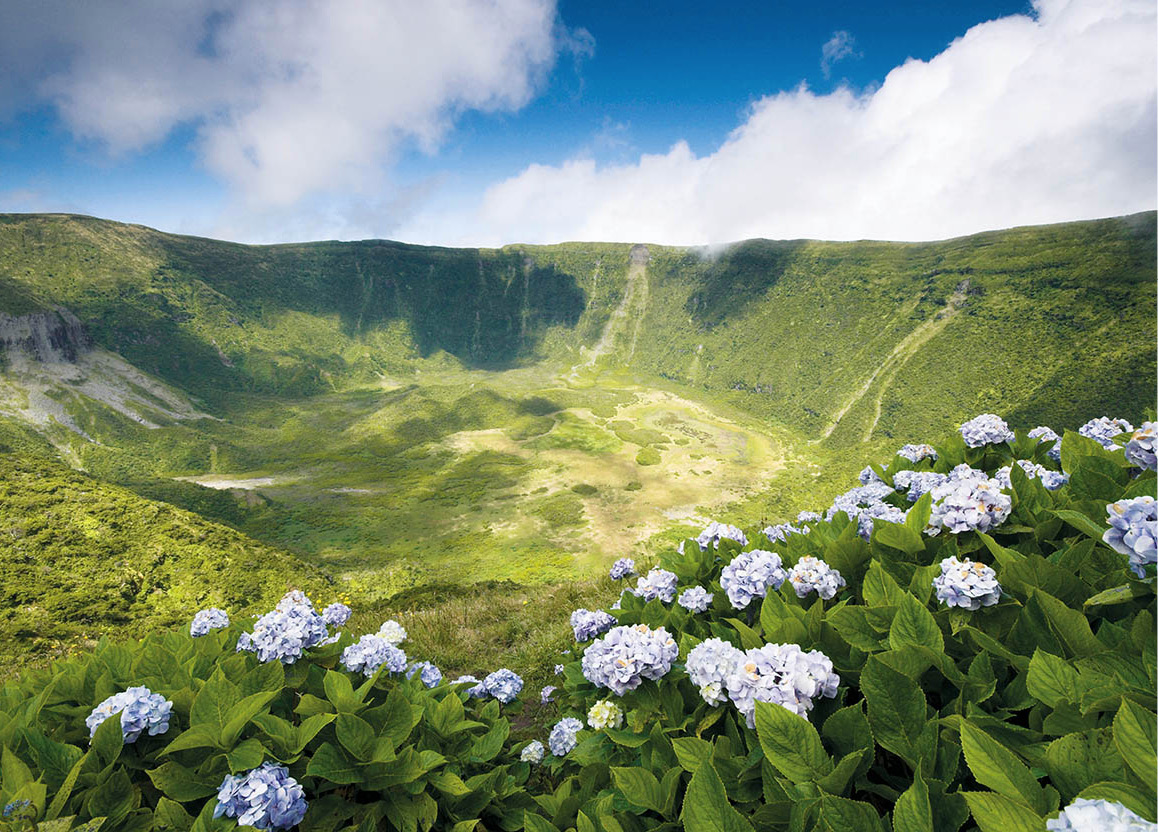
Volcanic crater at the Reserva Natural da Caldeira do Faial.
AWL Images
